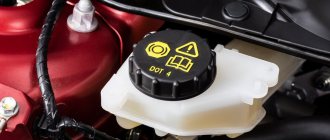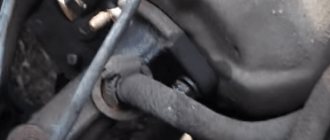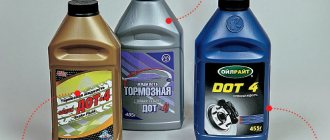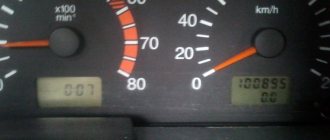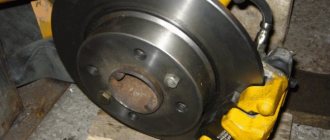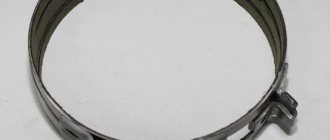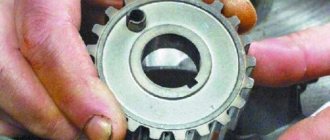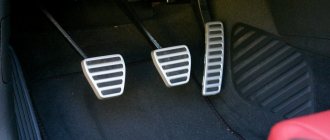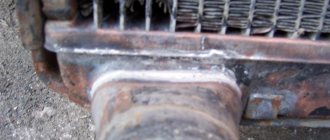During operation and even when storing a car in a garage, its components and assemblies are affected by various factors. These are humidity, dry air, low temperature, temperature changes, overheating and much more.
This can damage various components, including the brake pipe. Many motorists have encountered a situation where it has become stuck or soured, and there has been a need to disconnect it from the caliper, cylinder or brake hose.
Oddly enough, but a similar problem occurs more often on domestically produced machines. This does not mean that all owners of foreign cars are insured against pipe souring. It just happens a little less often for them.
How to unscrew a brake pipe. If it has soured and the edges are torn off! Let's disassemble the hose and cylinder
Not long ago I wrote an article about how to unscrew a stuck bolt, say on a muffler . My readers liked the article, they asked me to tell you about dismantling a soured brake pipe. After all, on used cars this is a real problem, and it is difficult to unscrew both from the caliper or cylinder, and from the brake hose itself. WE WILL solve the problem. Well, today there are some useful tips on installing these tubes, there will be a video, so read and watch...
I myself have encountered brake pipes many times on our VAZs, from 2101 to 2114; of course, if you go to a service station, they will easily and quickly unscrew them for you. But if you climbed it yourself, and have never done this before, and even if the mileage on the car is huge and the brake fluid has almost never been changed! It will be triple difficult to do this.
As you know, the main reason for sticking of any element in a car is operation at elevated temperatures. If it is obvious that there is a high temperature in the internal combustion engine during operation, then drivers may wonder what is causing the brake pipe to become soggy. It's very simple, when the car brakes, the calipers and drums absorb energy, accordingly, heat is released, and the components of the braking system become very hot. When water gets on these components, for example, when running over a puddle, they cool sharply, which is why sticking occurs.
Also, do not forget about the various chemicals, dirt and other liquids that fall from the road onto the brake pipe and its fastening mechanism. In addition, if a car's brake fluid contains a large amount of water, it begins to oxidize system elements from the inside, including the brake pipe connection.
Features of unscrewing a rusted tube
Parts of the brake system (TS), except for “consumables”, last quite a long time, mainly the pads and, if necessary, discs are changed on the car. Connections of brake pipes (TT), cylinders, hoses “sour” over time for a number of reasons:
- Dirt, salt, and moisture enter the parts located at the bottom of the car from the road;
- the temperature difference influences - when the pads interact with the drums/discs, heating occurs, when water or snow “porridge” gets in, a sharp cooling occurs;
- nuts, fittings, bolts are not loosened for a long time, a kind of sticking occurs.
Unscrewing a stuck TT from the working cylinder after a long mileage (say, after 100 thousand km) is problematic if you don’t know how to do it correctly, because many people pick up a regular open-end wrench. As a rule, the key immediately slips through the fitting, the edges roll up, and then difficulties arise in disconnecting the CT, and you have to contact specialists.
Basic rules for unscrewing the tube:
Using a special wrench is quite simple: twist the clamping bolt, place the wrench on the fitting, tighten and clamp the bolt so that the hexagon is tightly grasped, without any play. After this, we begin unscrewing, but we cannot use much force, as the tube may break off.
In a car service center, they often use a gas cutter and heat the joint. But here you need to heat it extremely carefully; it is possible that the cylinder cuffs will be damaged.
Fuel pipes
The fuel line pipes are connected using a different type of fastening, and are removed completely differently, but most often they are also pre-sprayed with WD-40.
Attention! When working on the fuel system, it is recommended to disconnect the negative battery cable; smoking and using open flame sources are prohibited!
If your car is relatively new or has already had a fuel line replaced, chances are that modern quick-release fittings were chosen for installation. Fastening of the coupling is ensured by special antennae, or clamps, which are located inside the clamp and are activated by one or two buttons at its base. No additional tools are required for removal.
Removing the brake wheel cylinder
On cars with drum brakes, working cylinders are installed on the rear axle; the problem is that their mounting bolts boil and break off in the housing. When the cylinder is being replaced, there is no problem, but in some cases the part needs to be preserved, and after removal it must be put back in place.
In order not to break off the fasteners (usually the cylinder is held on by two bolts), before unscrewing, you should also tap with a hammer through a drift; you can knock on the bolts themselves (being careful not to spoil or flatten the edges), next to the fasteners on the cylinder body. And here we don’t forget to use WD-40, this usual method helps without fail. You should unscrew the bolts with a socket wrench, do not force the bolts off and, again, do not rush.
When the edges are rolled up
If the edges of the brake line, hose or bleeder are already rounded, it is difficult to loosen the connection, but there are ways to help solve the problem. You can do the following:
- use a special grip wrench (plumbing pliers) to unscrew;
- to remove the brake pipe, make a cut on the side in the wrench head of the appropriate size (using a grinder), cut off two edges on top to install the wrench, secure the resulting device to the TT and unscrew the fitting;
- To “bleed” it, use a new hex head; trying to unscrew the fitting with a spanner, or even more so with an open-end wrench, is no longer acceptable here - the edges will become even worse.
To “soak” a soured connection, you should use not only WD-40, but also diesel fuel or kerosene; it is important to unscrew it not immediately, but in small jerks, then the tube or fitting will not break off. And don’t forget about heating and tapping; such methods are more effective than various cunning devices.
How to unscrew the brake pipe?
#1 Denis M
- Users
- 4,372 Messages
- Gender: Man
- City: Kolpino
- Car:
Audi 80 avant - year of issue:
1994
Today the brake hose broke. When replacing, one side (closer to the wheel) unscrewed normally, but on the other all the edges were torn off. In short, it just turned out to be a round head. Are there any gurus who have encountered this? I myself am thinking of drilling a hole in this round hat. and try to unscrew it with a drill inserted into it.
I also came up with the idea of unscrewing it with a chisel.
- Top
#2 JoySpirit
- Gender: Man
- City: St. Petersburg, Petrogradka
- Car:
Audi Fan - year of manufacture:
since 2007
- Top
#3 Denis M
- Gender: Man
- City: Kolpino
- Car:
Audi 80 avant - year of issue:
1994
Why bother and unscrew? Replace the entire tube from the GTZ. A new copper tube costs 200 rubles. In my opinion, it’s simpler and more reliable.
- Top
#4 DiCh
- Gender: Man
- City: St. Petersburg, Grazhdanka
- Car:
KIA Sorento - year of issue:
2003
- Top
#5 Denis M
- Gender: Man
- City: Kolpino
- Car:
Audi 80 avant - year of issue:
1994
Use a grinder to cut off the rest of the tube and pull it out. Business for 30 seconds.
- Top
#6 RomaNASN
- Car:
Audi A6 3.0 Qattro
- Top
#7 Denis M
- Gender: Man
- City: Kolpino
- Car:
Audi 80 avant - year of issue:
1994
Try sawing it off with a blade or a piece of linen. Or cut off the “tail” so that only one fitting remains and try to unscrew it with the head. Soviet clamping keys are also sold.
- Top
#8 Tima78
- City: St. Petersburg Kirovsky district
- Car:
Skoda Octavia - year of issue:
2011
- Top
#9 [email protected]
The edges are broken, what should I do?
Not everyone reads my articles and, as usual, we go under the car with a regular key. What happens, the oxidation is very strong, we try to unscrew it and “bang” - the edges are torn off, the nut becomes round, it is almost impossible to unscrew it. What to do? There are several ways, but often the only thing that will help you is “breaking off” the tube and removing the caliper, cylinder or hose completely!
No matter how sad it sounds:
- Again, we try to work out the place with WD-40. This product knows its stuff and often helps even problem areas
- We take the key (which I wrote about above), put it on, and tighten the bolt. We try to unscrew it, the whole point is that sometimes some edge remains and it can get caught on it. If it scrolls, you need to cut the tube
Actually, next we break (cut) the tube and remove the caliper or cylinder itself, here again we have several ways:
- You need to take the correct head, in which the force is applied not to the corners of the nut, but to the edges. Let's watch this useful video and you'll understand everything.
- If the case is completely advanced, you can try to grind off a few edges with a file, give it a square look and then clamp it in a vice and try to unscrew it
However, it happens that the nut simply breaks, and a part remains inside; this is an even more complicated case.
Here again there are several options:
- Drill out. That is, take a drill of approximately the same diameter as the hole, then drill out a part of the nut and tube EXACTLY, after that we take a tap and cut the thread. This is a VERY complex and precise process, not everyone can handle it
- This is to weld a washer or a nut of larger diameter to part of the nut and try to unscrew it. It’s also difficult, but you don’t need to cut anything. Again a useful video.
In conclusion, I would like to say that I have had cases when I had to buy a new brake cylinder because the old one just wouldn’t budge. And after drilling out the tube, the drill went in the wrong direction, and it was impossible to cut the thread! Fortunately, for a VAZ, a rear brake cylinder costs a penny, as do brake hoses.
I also want to note - CHANGE THE BRAKE FLUID ACCORDING TO REGULATION (usually 2 - 3 years), do not let moisture accumulate in it! You may not even need to remove anything.
I end here, SINCERELY your AUTOBLOGGER. We like and repost the article.
(
10 votes, average: 5.00 out of 5)
Similar news
Rust converter composition. Can I do it myself?
Anti-squeak plates for brake pads. Why are i needed?
Required Tools
- Special split wrench “8/10” for unscrewing brake pipes
- Open-end wrench "17"
- Socket wrenches for “14” and “10” or heads for the same bolts
- Pliers or round nose pliers
To replace the front brake hoses on a classic, you will need a narrow metal brush to clean the bolted joints from dirt and a rubber cap to “plug” the metal tube. This cap can be taken from the bleeder fitting of the working brake cylinder. We'll talk about how to use it below. I advise you to buy new copper sealing washers in the amount of 4 pieces.
Posts 1 page 9 of 9
Share116.07.2013 16:57
- Author: warwar
- Neon Guru
- From: Vyborg
- Gender: Male
- Posts: 3206
- Respect: +73
- ICQ: 468187577
- Last visit: 06/09/2019 17:11
- Registered: 01/21/2009
- Spent on the forum: 1 month 23 days
Can anyone tell me what else can be used? The brake cylinder was leaking. I could only unscrew it by turning the cylinder because the tube screwing into the cylinder had become sour. I’ve been heating it with a hairdryer for a couple of hours now and pouring water on it. It doesn’t help at all. How else can you stir it up? ((((maybe there are other ways? Is vinegar better than Vedashka? Maybe I should try them?
How does the braking system work?
The hydraulic brake system used on most passenger cars consists of a master and four brake wheel cylinders connected by high-pressure pipes and brake hoses.
The operating principle is as follows: when you press the brake pedal , the master cylinder chamber moves through tubes and hoses to the workers , forcing them to compress the pads.
At this moment, the pressure in the brake system increases, which often leads to rupture of the hoses in places of damage, after which the pressure in the system is compared with atmospheric pressure, and pressing the brake pedal again leads to the ejection of fluid from the circuits. The working cylinders stop compressing the pads and the brakes disappear. To restore the system, you need to stop the leak and bleed the brakes.
Preventing brake pipe breakage
Naturally, in order not to waste a lot of time in the future searching for breakdowns and repairs, it is best to treat your vehicle with care. Don't be lazy, just follow these simple tips:
- Periodically inspect the brake lines for rust and defects. Contamination, microcracks, and corrosion lead to incorrect operation of the system.
- Change the brake fluid according to the regulations.
- Check the tightness of the fasteners.
- Treat surfaces with anti-corrosion agents.
- Avoid leaking brake fluid.
- Become an advocate for careful driving. It is not uncommon for tubes to rupture when overcoming obstacles.
- Have your brakes inspected at least once every two years. Motorists who spend a lot of time on the road should do this after every fifty thousand miles.
- Regularly monitor the wear and tear of vehicle parts, and it will take care of your safety.

